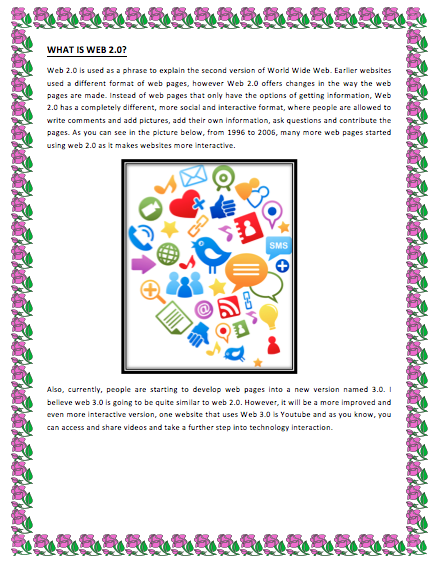- On average, how many hours do you use the internet for daily?
- How many of these hours are spent on social networking websites?
- What social networking websites do you use?
- Do you use youtube? What for?
- What websites do you use as a student?
- Are any of them in Web 2.0 format?
- Do you like Web 2.0?
- How does web 2.0 help your daily life?
- Is any part of Web 2.0 a disadvantage for you?
- Do you know what Web 3.0 is?
Monday, 28 April 2014
Web 2.0 Questionnaire
Questions:
Sunday, 27 April 2014
AREA OF INTERACTION RELATION
One of the areas of interaction for questionnaires and Web 2.0 in general is Community and Service. Basically, Web 2.0 is a version of the web targeted at everyone in the world and it really helps people in many different ways. For example, it allows easier social interaction and communication using social networking websites like Facebook. Also, it lets people ask questions about something they're worried about or need help with or even just want to know about and they can get different opinions on it. In addition to that, search engines now allow people to create accounts, one of them being on google and that is a much easier way that allows interaction and keeping track of what you're looking for. Questionnaires also relate to Community and Service because they show community involvement. When presenting a questionnaire to someone, it shows willingness to be involved in the community. Also, by collecting data from questionnaires, many people decide to find solutions to problems they are presented with and that also relates to this area of interaction. In this case, I am showing committed willingness to participate in finding out more about the community using questionnaire. Another is Human Ingenuity, in this area of interaction, the main idea is create develop and change. Web 2.0 is a new version of the web and that is development and change within web versions. Also, the fact that so many websites are being created due to the development of web 2.0 is a relation to Human ingenuity. In regard to questionnaires, by solving problems we are presented in after gathering data within a community, we are developing and changing things, depending on what the solution to the problem is. Overall, these two areas of interaction are focused on in Web 2.0 and questionnaires.
Saturday, 26 April 2014
Questionnaire Research
What are questionnaires used for?
Questionnaires are a great method to analyze the opinions, expectations, general knowledge and much more of people within a certain category. They help gather data about a certain number of people and that will help us understand and assume the aim of the questionnaire for people all over the world. In addition to that, questionnaires are a flexible concept, which means they can be used in many different contexts. For example, they can be used to find out a percentage of people under 20 years old who own a mobile phone in Dubai. If the questionnaire is carried out in the way of a survey and 500 people who are under 20 years old complete it, we can generally assume approximately how many people under 20 years old own a phone in Dubai. This means that if we can get a certain number of people to answer the same question or set of questions, we can make a judgement of what most people think or do without asking every single one of then. This is the reason why questionnaires and surveys play a very important role in research about the general public population. It helps us understand what most people think or do, depending on the questions. Also, questionnaires can be used for testing people's knowledge about a certain topic. As an example, if we ask 1000 people from all over the world to identify what a strawberries are, we can find out people's knowledge about fruits. Another way a questionnaire is used is to analyze people's opinions and make a decision based on the majority of the result. For example, a restaurant could have the idea of changing a certain appetizer, if they ask people which idea they prefer, they can form a decision of whether to change the appetizer on not depending on what the majority of the people prefer. Also, another example is to analyze the behavior of a certain age group and compare it to another based on a set of questions that show ones behavior and actions. Basically, to sum up, questionnaires and surveys can be used for a variety of purposes, including collecting data, patterns and research about opinions, expectations, knowledge, preferences, behavior etc.
Friday, 25 April 2014
Web 2.0 Research Reflection
After researching about Web 2.0, I feel like I have a detailed knowledge about what it is and how its used. It was an interesting task and I loved working on it, the best part was gaining more information about how the web was developed and that is why I really enjoyed this topic. To go a little further, I researched about Web 3.0 so I could get a better understanding of the development and differences. There wasn't any struggle along the way, however some questions were about something that I couldn't really research, so I had to think about my own experience and use my previous knowledge to answer them. Overall, it was great and I hope to use this information in other tasks including our topics about questionnaires.
Wednesday, 16 April 2014
Subscribe to:
Comments (Atom)






